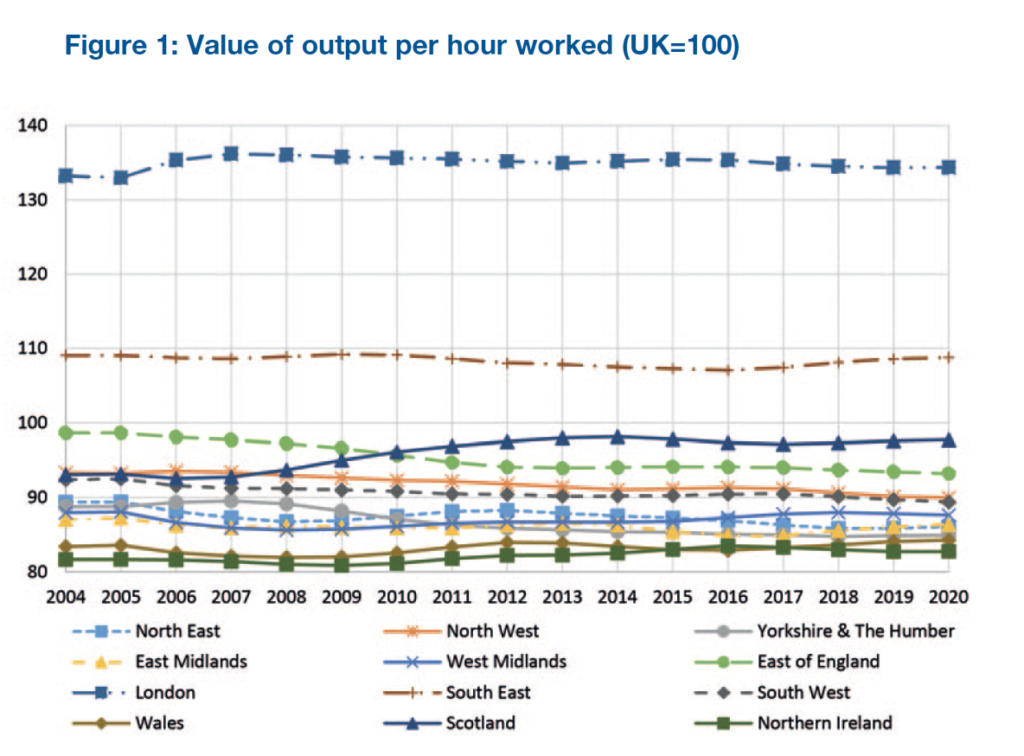Northern Ireland’s productivity gap

Research Fellow with the Northern Ireland Productivity Forum at Queen’s University Belfast, David Jordan outlines the key causes of Northern Ireland’s large productivity gap.
Northern Ireland’s economy currently faces several challenges. The effects of the pandemic are still being felt, with households facing double digit inflation, and a recession expected by the end of the year. Meanwhile, the situation surrounding the Northern Ireland Protocol continues to create uncertainty for local businesses.
Yet the biggest challenge facing the local economy is low productivity.
Productivity measures the total value of output produced for a given amount of work. It is a key driver of higher wages and living standards. The UK’s productivity growth has stagnated since the 2007-2008 financial crisis. This problem is even more pronounced in Northern Ireland, where productivity is 17 per cent below the UK average, and consistently the worst of any UK region (Figure 1).
At the Northern Ireland Productivity Forum, based at Queen’s Management School, we have been looking at the reasons for Northern Ireland’s productivity gap. It is not a new phenomenon, as the gap existed prior to the 2007-2008 financial crisis, the Troubles, and even partition. Examining the evidence suggests a combination of factors is to blame.
Northern Ireland’s higher concentration in low productivity sectors, such as agriculture and retail, is often presented as the main reason for low productivity. Yet, if Northern Ireland had the same economic structure as Great Britain, this would reduce the productivity gap by less than half. While increasing employment in high productivity sectors is beneficial, policymakers equally need to address the ‘long tail’ of low productivity firms which lag behind their peers.
Geographic peripherality is sometimes blamed for Northern Ireland’s low productivity, due to local producers potentially facing higher transport costs, and a small domestic market. However, transport costs have been shown to be only marginally higher. Instead, it is distance from networks and knowledge which creates a barrier to productivity growth.
During the 20th century, local policymakers focused on raising levels of capital to try and address low productivity. Today, the amount of capital per worker is around the UK average, but the productivity gap remains. Attention has instead turned to levels of innovation. Northern Ireland is one of the UK regions with the lowest R&D intensity, with it being concentrated in a small number of large firms.
Skills and training are strongly linked to productivity; this is an area where Northern Ireland has persistently underperformed. A skills deficit exists, with Northern Ireland having the highest proportion of individuals with no or low skills of any UK region. The brain drain of tertiary educated individuals is not as severe as it once was, but this has yet to be translated into improved productivity.
“Tackling low productivity is often stated as an aspiration of policymakers, but it is rarely used to measure the outcome of interventions.”
Northern Ireland’s infrastructure gap has been linked to low productivity. Public expenditure on infrastructure lags behind the rest of the UK, particularly in transport and the water network, and reflects a long-run pattern of underinvestment. This makes it more difficult to attract new investment, and limits opportunities for existing firms to grow.
Policymakers have long been aware of the productivity gap, but policy interventions have a poor track record. In the past, high levels of unemployment, particularly in manufacturing, saw generous financial support provided to firms. But this led to a low-skilled workforce producing low-value goods, and allowed low-productivity firms to survive. Recent policy has focused on entrepreneurship and innovation, but the productivity gap has persisted.
Several potential reasons exist for the failure of policy. Past problems were often misdiagnosed, while policy interventions have not been sufficiently joined-up to address areas of weakness. Tackling low productivity is often stated as an aspiration of policymakers, but it is rarely used to measure the outcome of interventions. Northern Ireland’s large public sector has been suggested as contributing to the productivity gap, by absorbing skilled labour and crowding out private investment. The alternative view is that the effectiveness of public policy in building a successful private sector is more important for competitiveness.
Institutions and governance may best explain past policy failures. Productivity has often been subordinate to other institutional priorities, such as political stability. During ‘the Troubles’, public expenditure was used to stabilise the economy, with policymakers balancing economic and non-economic considerations. Today, the legacy of a divided society has been linked to the emigration of skilled labour, and long-term health problems affecting the productivity of those in work.
The evidence demonstrates that Northern Ireland’s problem of low productivity is complex, with no single cause. While economic structure, geographic peripherality, and levels of capital were important in the past, today’s biggest barriers to productivity growth can be found in low levels of R&D, skills, and infrastructure. But closing the productivity gap is not an insurmountable challenge. The ability to do so will depend on whether local institutions can overcome their past failings, and improve the quality and effectiveness of policy interventions, so that the local economy can reach its full potential.






